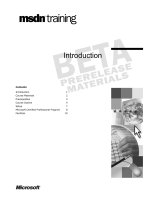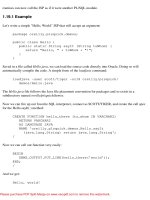JavaScript: A Crash Course – Core Language Syntax pdf
Bạn đang xem bản rút gọn của tài liệu. Xem và tải ngay bản đầy đủ của tài liệu tại đây (2.42 MB, 28 trang )
© 2009 Marty Hall
JavaScript:
A Crash Course
Part I: Core Language Syntax
Part I: Core Language Syntax
Originals of Slides and Source Code for Examples:
/>-
Materials/ajax.html
Customized Java EE Training: />Servlets, JSP, JSF 1.x & JSF 2.0, Struts Classic & Struts 2, Ajax, GWT, Spring, Hibernate/JPA, Java 5 & 6.
Developed and taught by well-known author and developer. At public venues or onsite at your location.
/>Materials/ajax.html
© 2009 Marty Hall
For live Ajax & GWT training, see training
t htt // l t /
courses
a
t htt
p:
//
courses.coreserv
l
e
t
s.com
/
.
Taught by the author of Core Servlets and JSP, More
Servlets and JSP
and this tutorial Available at public
Servlets and JSP
,
and this tutorial
.
Available at public
venues, or customized versions can be held on-site at
your
organization.
CdlddthtbMtHll
Customized Java EE Training: />Servlets, JSP, JSF 1.x & JSF 2.0, Struts Classic & Struts 2, Ajax, GWT, Spring, Hibernate/JPA, Java 5 & 6.
Developed and taught by well-known author and developer. At public venues or onsite at your location.
•
C
ourses
d
eve
l
ope
d
an
d
t
aug
ht
b
y
M
ar
t
y
H
a
ll
– Java 6, intermediate/beginning servlets/JSP, advanced servlets/JSP, Struts, JSF 1.x & 2.0, Ajax, GWT, custom mix of topics
– Ajax courses can concentrate on one library (jQuery, Prototype/Scriptaculous, Ext-JS, Dojo) or survey several
• Courses developed and taught by coreservlets.com experts (edited by Marty)
– Spring, Hibernate/JPA, EJB3, Ruby/Rails
Contact for details
Topics in This Section
• Overview
• JavaScript references
• Embedding in browser
• Basic syntax
• Strings and regular expressions
• Functions
• Objects
5
© 2009 Marty Hall
Intro
Customized Java EE Training: />Servlets, JSP, JSF 1.x & JSF 2.0, Struts Classic & Struts 2, Ajax, GWT, Spring, Hibernate/JPA, Java 5 & 6.
Developed and taught by well-known author and developer. At public venues or onsite at your location.
Books
• JavaScript the Definitive Guide
By David Flanagan O
’
Reilly The only really complete reference
–
By
David
Flanagan
,
O Reilly
.
The
only
really
complete
reference
on the JavaScript language. Thorough and well-written.
• Makes the global variable blunder when covering Ajax.
•
JavaScript: The Good Parts
JavaScript:
The
Good
Parts
– By Douglas Crockford (of JSON and YUI fame), O’Reilly
– Outstanding advanced guide to best practices in core JavaScript,
es
p
eciall
y
functions
,
ob
j
ects
,
and re
g
ular ex
p
ressions. Ver
y
short.
py ,j, g p
y
• Does not cover Ajax at all. No DOM scripting. “The K&R of JS”.
• Pro JavaScript Techniques
–
B
y
John Resi
g
(
of
jQ
uer
y
fame
),
APress
y
g
(jQ y ),
– Excellent guide to best practices; not a thorough reference
• Does not make the global variable blunder when covering Ajax.
• DOM Scri
p
tin
g
pg
– By Jeremy Keith, FriendsOf Press
– Focuses on manipulating DOM and CSS
• Makes the global variable blunder when briefly covering Ajax.
7
Online References
• JavaScript tutorial (language syntax)
•
http://www w3schools com/js/
•
http://www
.
w3schools
.
com/js/
• />Core_JavaScript_1.5_Guide
•
JavaScript API references (
builtin
objects)
JavaScript
API
references
(
builtin
objects)
• />• />QuickRef/
• />• />• />Core_JavaScript_1.5_Reference
• HTML DOM reference (with JavaScript Examples)
• />• Official ECMAScript specification
• />Ecma-262.htm
8
Firebug
• Install Firebug in Firefox
– />• Use Firebug console for interactive testing
h//fib /lhl
–
h
ttp:
//
get
fi
re
b
ug.com
/
c
l
.
h
tm
l
• Can also use Firebug Lite in Internet
Explorer
Explorer
– Not great, but better than nothing
– htt
p
://
g
etfirebu
g
.com/lite.html
pg g
• See especially “bookmarklet” link
• For more details on Firebug usage
– See section on Ajax development and debugging tools
9
© 2009 Marty Hall
Embedding JavaScript
Embedding
JavaScript
in HTML
Customized Java EE Training: />Servlets, JSP, JSF 1.x & JSF 2.0, Struts Classic & Struts 2, Ajax, GWT, Spring, Hibernate/JPA, Java 5 & 6.
Developed and taught by well-known author and developer. At public venues or onsite at your location.
Loading Scripts
• script with src
• <script src="my-script.js" type="text/javascript"></script>
– Purpose
•
To define functions, objects, and variables.
To
define
functions,
objects,
and
variables.
• Functions will later be triggered by buttons, other user
events, inline script tags with body content, etc.
•
script with body content
•
script
with
body
content
• <script type="text/javascript">JavaScript code</script>
– Pur
p
ose
p
• To directly invoke code that will run as page loads
– E.g., to output HTML content built by JavaScript
•
Don
’
t
use this approach for defining functions or for doing
Don t
use
this
approach
for
defining
functions
or
for
doing
things that could be done in external files.
– Slower (no browser caching) and less reusable
11
Example (phish.js)
function getMessage() {
var amount
=
Math round
(
Math random
()
*
100000);
var
amount
Math
.
round
(
Math
.
random
()
100000);
var message =
"You won $" + amount + "!\n" +
"To collect
y
our winnin
g
s
,
send
y
our credit car
d
\n" +
yg,y
"and bank details to ";
return(message);
}
“alert” pops up dialog box
function showWinnings1() {
alert(getMessage());
}
“
dtit
”
i t t t i t t t l ti
}
function showWinnings2() {
document write
(
"
<h1><blink>
"
+
getMessage
() +
“
d
ocumen
t
.wr
it
e
”
i
nser
t
s
t
ex
t i
n
t
o
pa
g
e
a
t
curren
t l
oca
ti
on
document
.
write
( <h1><blink>
+
getMessage
()
+
"</blink></h1>");
}
12
Example (loading-scripts.html)
<!DOCTYPE ><html xmlns=" /><head><title>Loading Scripts</title>
<head><title>Loading
Scripts</title>
<script src="./scripts/phish.js"
type="text/
javascript
"></script>
Loads script from previous page
type="text/
javascript
"></script>
</head>
<body>
Calls showWinnings1 when user presses
<input type="button" value="How Much Did You Win?"
onclick='showWinnings1()'/>
button. Puts result in dialog box.
<script type="text/javascript">showWinnings2()</script>
//
</
body><
/
html
>
13
Calls showWinnings2 when page is loaded in
browser. Puts result at this location in page.
Example (Results)
14
Loading Scripts: Special Cases
• Internet Explorer bug
– Scripts with src fail to load if you use <script />.
• You must use <script src=" " ></script>
• XHTML: Scripts with body content
– It is an error if the body of the script contains special
XML h t h & <
XML
c
h
arac
t
ers suc
h
as
&
or
<
– E.g. <script >if (a<b) { this(); } else { that(); }</script>
So use CDATA section unless body content is simple
–
So
,
use
CDATA
section
unless
body
content
is
simple
and clearly has no special characters
• <script type="text/javascript"><![CDATA[
JavaScript Code
]]></script>
15
© 2009 Marty Hall
Basic Syntax
Customized Java EE Training: />Servlets, JSP, JSF 1.x & JSF 2.0, Struts Classic & Struts 2, Ajax, GWT, Spring, Hibernate/JPA, Java 5 & 6.
Developed and taught by well-known author and developer. At public venues or onsite at your location.
Variables
• Introduce with “var”
– For global variables (!) and local variables.
– No “var” for function arguments
You do not declare types
•
You
do
not
declare
types
– Some people say JavaScript is “untyped” language, but
reall
y
it is “d
y
namicall
y
t
yp
ed” lan
g
ua
g
e
y
yyyp
gg
– JavaScript is very liberal about converting types
• There are only two scopes
– Global scope
• Be very careful with this when using Ajax.
•
Can
cause race conditions
•
Can
cause
race
conditions
.
– Function (lexical) scope
– There is not block scope as in Java
17
Operators and Statements
• Almost same set of operators as Java
+ (addition and String concatenation)
*/
–
+
(addition
and
String
concatenation)
, -,
*
,
/
– &&, ||, ++, , etc
– The == comparison is more akin to Java's "equals"
The === operator (less used) is like Java
'
s==
–
The
===
operator
(less
used)
is
like
Java s
==
• Statements
– Semicolons are technically optional
•
But highly recommended
•
But
highly
recommended
– Consider
• return x
•
return
return
x
• They are not identical! The second one returns, then evaluates
x. You should act as though semicolons are required as in Java.
Comments
•
Comments
– Same as in Java (/* */ and // )
18
Conditionals and Simple Loops
• if/else
– Almost identical to Java except test can be converted to
true/false instead of strict true/false
• “
false
”
: false null undefined
""
(empty string) 0
NaN
false :
false
,
null
,
undefined
,
(empty
string)
,
0
,
NaN
• “true”: anything else (including the string “false”)
• Basic for loop
– Identical to Java except for variable declarations
• for(var i=0; i<someVal; i++) { doLoopBody(); }
•
while loop
•
while
loop
– Same as Java except test can be converted to boolean
• while(someTest) { doLoopBody(); }
• do/while loop
– Same as Java except test can be converted to boolean
19
Array Basics
• One-step array allocation
– var primes = [2, 3, 5, 7, 11, 13];
– var names = ["Joe", "Jane", "John", "Juan"];
•
No
trailing comma after last element (see later slide)
•
No
trailing
comma
after
last
element
(see
later
slide)
• Two-step array allocation
– var names = new Arra
y(
4
)
;
y( )
;
names[0] = "Joe";
names[3] =
"
Juan
"
;
names[3]
=
Juan ;
• Indexed at 0 as in Java
– f
o
r
(va
r i=
0;
i<n
a
m
es.
l
e
n
gt
h
;
i++
)
{
o(va
0;
aes.egt
;
){
doSomethingWith(names[i]);
}
20
Other Conditionals and Loops
• switch
– Differs from Java in two ways
• The “case” can be an expression
•
Values need not be
ints
(compared with
===
)
Values
need
not
be
ints
(compared
with
)
• for/in loop
– On surface, looks similar to Java for/each loop, but
• For arrays, values are array indexes, not array values
– Use this loop for objects (to see property names), not arrays!
Fails with Prototype or other extended arrays
• For objects, values are the property names
– var names = ["Joe", "Jane", "John", "Juan"];
for(
var
i
in names
){
for(
var
i
in
names
)
{
doSomethingWith(names[i]);
}
21
More on Arrays
• Arrays can be sparse
A()
– var names = new
A
rray
()
;
names[0] = "Joe";
names[100000] = "Juan";
• Arrays can be resized
– Regardless of how arrays is created, you can do:
•
myArray.length
=
someNewLength
;
myArray.length
someNewLength
;
• myArray[anyNumber] = someNewValue;
• myArray.push(someNewValue)
–
These are le
g
al re
g
ardless of which wa
y
m
y
Arra
y
was made
g
gy
yy
• Arrays have methods
– push, pop, join, reverse, sort, concat, slice, splice, etc.
•
See API reference
•
See
API
reference
• Regular objects can be treated like arrays
– You can use numbers
(
indexes
)
as
p
ro
p
erties
22
Arrays Example
function arrayLoops() {
var names =
["Joe", "Jane", "John"];
printArray1(names);
printArray2(names);
names.length = 6;
printArra 1(names)
printArra
y
1(names)
;
printArray2(names);
}
function printArray1(array) {
for(var i=0; i<array.length; i++) {
console.log("[printArray1] array[%o] is %o", i, array[i]);
}
}
function printArray2(array) {
for(var i in array) {
console.log is a printf-like way to print output in Firebug
Console window. For testing/debugging only.
console.log("[printArray2] array[%o] is %o", i, array[i]);
}
}
arrayLoops();
23
Direct call for interactive testing in Firebug console.
(Cut/paste all code into console command line.)
Array Performance
Time to create and sum array of 16 million random numbers
7
8
9
4
5
6
7
1
2
3
4
0
1
JavaScri
p
t:
p
Firefox 3
JavaScript:
Google Chrome
Java: 1.6_0_10
24
Note: Internet Explorer 7 was more than 10 times slower than Firefox, so times are not shown here.
Source code for benchmarks is in downloadable Eclipse project at coreservlets.com.
The Math Class
• Almost identical to Java
– Like Java, static methods (Math.cos, Math.random, etc.)
– Like Java, logs are base e, trig functions are in radians
Functions
•
Functions
– Math.abs, Math.acos, Math.asin, Math.atan, Math.atan2,
Math.ceil
,
Math.cos
,
Math.ex
p,
Math.floor
,
Math.lo
g,
,,p,
,g,
Math.max, Math.min, Math.pow, Math.random,
Math.round, Math.sin, Math.sqrt, Math.tan
Constants
•
Constants
– Math.E, Math.LN10, Math.LN2, Math.LOG10E,
Math.PI
, Math.SQRT1 2, Math.SQRT2
Math.PI
,
Math.SQRT1
_
2,
Math.SQRT2
25
© 2009 Marty Hall
Strings and
Strings
and
Re
g
ular Ex
p
ressions
gp
Customized Java EE Training: />Servlets, JSP, JSF 1.x & JSF 2.0, Struts Classic & Struts 2, Ajax, GWT, Spring, Hibernate/JPA, Java 5 & 6.
Developed and taught by well-known author and developer. At public venues or onsite at your location.
String Basics
• You can use double or single quotes
var names = [
"
Joe
"'
Jane
'"
John
"'
Juan
'
];
–
var
names
=
[Joe
,
Jane
,
John
,
Juan ];
• You can access length property
– E.g., "foobar".length returns 6
Nb b tdtti
•
N
um
b
ers can
b
e conver
t
e
d
t
o s
t
r
i
ngs
– Automatic conversion during concatenations.
String need not be first as in Java
•
var
val
=3+
"
abc
"
+ 5; // Result is
"
3abc5
"
•
var
val
=
3
+
abc
+
5;
//
Result
is
3abc5
– Conversion with fixed precision
• var n = 123.4567;
var val = n.toFixed
(
2
);
// Result is 123.46
(
not 123.45
)
(); ( )
• Strings can be compared with ==
– "foo" == 'foo' returns true
•
Strings can be converted to numbers
Strings
can
be
converted
to
numbers
– var i = parseInt("37 blah"); // Result is 37 – ignores blah
– var d = parseFloat("6.02 blah"); // Ignores blah
27
Core String Methods
• Simple methods similar to Java
– charAt, indexOf, lastIndexOf, substring, toLowerCase,
toUpperCase
•
Methods that use regular expressions
•
Methods
that
use
regular
expressions
– match, replace, search, split
•
HTML methods
HTML
methods
– anchor, big, bold, fixed, fontcolor, fontsize, italics, link,
small, strike, sub, sup
• "test".bold().italics().fontcolor("red") returns
'<font color="red"><i><b>test</b></i></font>'
– These are technicall
y
nonstandard methods, but su
pp
orted
ypp
in all major browsers
• But I prefer to construct HTML strings explicitly anyhow
28
Regular Expressions
• You specify a regexp with /pattern/
N
ih S i i J
–
N
o
t
w
i
t
h
a
S
tr
i
n
g
as
i
n
J
ava
• Most special characters same as in Java/Unix/Perl
–
^
,
$
,
.
–
b
e
g
innin
g,
end of strin
g,
an
y
one cha
r
,,
gg, g,y
– \ – escape what would otherwise be a special character
– *, +, ? – 0 or more, 1 or more, 0 or 1 occurrences
–
{n} {n }
–
exactly n n or more occurrences
{n}
,
{n
,
}
exactly
n
,
n
or
more
occurrences
– [] – grouping
– \s, \S – whitespace, non-whitespace
\
w
\
W
word char (letter or number) non
word char
–
\
w
,
\
W
–
word
char
(letter
or
number)
,
non
-
word
char
• Modifiers
– /pattern/g – do global matching (find all matches, not just first one)
– /pattern/i – do case-insensitive matching
– /pattern/m – do multiline matching
29
Regular Expression: Examples
30
More Information on Regular
Expressions
Expressions
• Online API references given earlier
(S R E l )
(S
ee
R
eg
E
xp c
l
ass
)
– />http://www devguru com/technologies/ecmascript/
–
http://www
.
devguru
.
com/technologies/ecmascript/
QuickRef/regexp.html
• JavaScri
p
t Re
g
ular Ex
p
ression Tutorials
pg p
– />JavaScript/17/36435/
h// j iki /j /hl
–
h
ttp:
//
www.
j
avascr
i
pt
ki
t.com
/j
avatutors
/
re.s
h
tm
l
31
© 2009 Marty Hall
Functions
Functions
“
It is Lisp in C
’
s clothing.
”
It
is
Lisp
in
Cs
clothing.
- JSON and YUI guru Douglas Crockford, describing
the JavaScript language in JavaScript: The Good Parts.
Customized Java EE Training: />Servlets, JSP, JSF 1.x & JSF 2.0, Struts Classic & Struts 2, Ajax, GWT, Spring, Hibernate/JPA, Java 5 & 6.
Developed and taught by well-known author and developer. At public venues or onsite at your location.
Overview
• Not similar to Java
JSif i
diff f J h d
–
J
ava
S
cr
i
pt
f
unct
i
ons very
diff
erent
f
rom
J
ava met
h
o
d
s
• Main differences from Java
–
You can have global functions
You
can
have
global
functions
• Not just methods (functions as part of objects)
– You don’t declare return types or argument types
Caller can supply any number of arguments
–
Caller
can
supply
any
number
of
arguments
• Regardless of how many arguments you defined
– Functions are first-class datatypes
Y f ti d t th i t
•
Y
ou can pass
f
unc
ti
ons aroun
d
, s
t
ore
th
em
i
n arrays, e
t
c.
– You can create anonymous functions (closures)
• Critical for Ajax
• These are equivalent
– function foo( ) { }
– var foo = function( ) { }
33
Passing Functions: Example
function third(x) {
return(x / 3);
}
function triple(x) {
return
(
x * 3
)
;
()
}
function nineTimes(x) {
r
etu
rn
(
x * 9
);
etu ( );
}
function operate(
f
){
Function as argument.
function
operate(
f
)
{
var nums = [1, 2, 3];
for(var i=0; i<nums.length; i++) {
var num = nums[i];
console log(
"
Operationon%ois%o
"
console
.
log( Operation
on
%o
is
%o
.,
num, f(num));
}
}
34
Anonymous Functions
• Anonymous functions (or closures) let you
capture local variables inside a function
capture
local
variables
inside
a
function
– You can't do Ajax without this!
•
Basic anonymous function
Basic
anonymous
function
– operate(function(x) { return(x * 20); });
• Outputs 20, 40, 60
• The "operate" function defined on previous page
f
• Anonymous
f
unction with captured data
– function someFunction(args) {
var val = someCalculation(args);
return(
function(
moreArgs
){
return(
function(
moreArgs
)
{
doSomethingWith(val, moreArgs);
});
}
var f1 =
someFunction
(args1);
var
f1
=
someFunction
(args1);
var f2 = someFunction(args2);
f1(args3); // Uses one copy of "val"
f2(args3); // Uses a different copy of "val"
35
Anonymous Functions: Example
function multiplier(m) {
return(function(x)
{ return(x * m); });
}
function operate2() {
var nums = [1, 2, 3];
var functions =
[multiplier(1/3), multiplier(3), multiplier(9)];
for(var i=0; i
<
functions.length; i++) {
for(var j=0; j<nums.length; j++) {
var f = functions[i];
var num = nums[j];
console.lo
g
("O
p
eration on %o is %o.",
gp
num, f(num));
}
}
}
36
Optional Args: Summary
• Fixed number of optional args
– Functions can always
b
e called with any number of args
– Compare typeof args to "undefined"
See next page and upcoming
convertString
function
–
See
next
page
and
upcoming
convertString
function
• Arbitrary args
–
Discover number of
args
with
arguments length
Discover
number
of
args
with
arguments
.
length
– Get arguments via arguments[i]
– See next page and upcoming longestString function
• Optional args via anonymous object
– Caller always supplies same number of arguments, but
f th t i (JSON) bj t
one o
f
th
e argumen
t
s
i
s an anonymous
(JSON)
o
bj
ec
t
• This object has optional fields
– See later exam
p
le in “Ob
j
ects” section
37
Optional Args: Details
• You can call any function with any number
f
o
f
arguments
– If called with fewer args, extra args equal "undefined"
•
You can use
typeof
arg
==
"
undefined
"
for this
•
You
can
use
typeof
arg
==
undefined
for
this
– You can also use boolean comparison if you are sure that no real
value could match (e.g., 0 and undefined both return true for !arg)
•
Use comments to indicate optional
args
Use
comments
to
indicate
optional
args
– function foo(arg1, arg2, /* Optional */ arg3) { }
– If called with extra args, you can use “arguments” array
Rdl fdfidibl
tl th
tll
•
R
egar
dl
ess o
f
d
e
fi
ne
d
var
i
a
bl
es, argumen
t
s.
l
eng
th
t
e
ll
s
you how many arguments were supplied, and arguments[i]
returns the designated argument
•
Use comments to indicate extra
args
•
Use
comments
to
indicate
extra
args
– function bar(arg1, arg2 /* varargs */) { }
38
Optional Arguments
function convertString(numString, /* Optional */ base) {
if (
typeof
base
== "
undefined
"
)
{
if
(
typeof
base
undefined )
{
base = 10;
}
var num = parseInt(numString, base);
console.log("%s base %o equals %o base 10.",
numString, base, num);
}
39
Varargs
function longestString(/* varargs */) {
var longest =
""
;
var
longest
=
;
for(var i=0; i<arguments.length; i++) {
var candidateString = arguments[i];
if (
candidateString length
>
longest length
){
if
(
candidateString
.
length
>
longest
.
length
)
{
longest = candidateString;
}
}
}
return(longest);
}
longestString("a", "bb", "ccc", "dddd");
// Returns "dddd"
40
© 2009 Marty Hall
Objects
Customized Java EE Training: />Servlets, JSP, JSF 1.x & JSF 2.0, Struts Classic & Struts 2, Ajax, GWT, Spring, Hibernate/JPA, Java 5 & 6.
Developed and taught by well-known author and developer. At public venues or onsite at your location.
Basics
• Constructors
Fi dfl Th
“”
–
F
unct
i
ons name
d
f
or c
l
ass names.
Th
en use
“
new
”
.
• No separate class definition! No “real” OOP in JavaScript!
– Can define properties with “this”
• You must use “this” for properties used in constructors
function MyClass(n1) { this.foo = n1; }
var m = new MyClass(10);
Pti(it ibl)
•
P
roper
ti
es
(i
ns
t
ance var
i
a
bl
es
)
– You don’t define them separately
• Wh
e
n
e
v
e
r
you
r
e
f
e
r
to
o
n
e,
Ja
v
aSc
ri
pt
just
c
r
eates
i
t
e e e you e e to o e, Ja aSc pt just c eates t
m.bar = 20; // Now m.foo is 10 and m.bar is 20
• Usually better to avoid introducing new properties in
outside code and instead do entire definition in constructor
• Methods
– Properties whose values are functions
42
Objects: Example
(Circle Class)
(Circle
Class)
function Circle(radius) {
this radius
= radius;
this
.
radius
=
radius;
this.getArea =
function() {
function()
{
return(Math.PI * this.radius * this.radius);
};
}
}
var c = new Circle(10);
() // 31 1 92
c.getArea
()
;
//
Returns
31
4.
1
5
92
43
The prototype Property
• In previous example
ECili fdi
–
E
very new
Ci
rc
l
e got
i
ts own copy o
f
ra
di
us
• Fine, since radius has per-Circle data
– Every new Circle got its own copy of getArea function
• Wasteful since function definition never changes
• Class-level properties
–
Classname prototype propertyName
=
value;
Classname
.
prototype
.
propertyName
value;
• Methods
– Classname.prototype.methodName = function() { };
• Just a special case of class-level properties
– This is legal anywhere, but it is best to do it in constructor
•
Pseudo
-
Inheritance
Pseudo
Inheritance
– The prototype property can be used for inheritance
– But complex. See later section on Prototype library
44
Objects: Example
(Updated Circle Class)
(Updated
Circle
Class)
function Circle(radius) {
this radius
= radius;
this
.
radius
=
radius;
Circle.prototype.getArea =
function() {
function()
{
return(Math.PI * this.radius * this.radius);
};
}
}
var c = new Circle(10);
() // 31 1 92
c.getArea
()
;
//
Returns
31
4.
1
5
92
45
Rolling Your Own Namespace
• Idea
Hld
fi hd bj i
–
H
ave re
l
ate
d
f
unct
i
ons t
h
at
d
o not use o
bj
ect propert
i
es
– You want to group them together and call them with
Utils.func1, Utils.func2, etc.
• Grouping is a syntactic convenience. Not real methods.
• Helps to avoid name conflicts when mixing JS libraries
– Similar to static methods in Java
• Syntax
– Assign functions to properties of an object, but do not
define a constructor E g
define
a
constructor
.
E
.
g
.,
• var Utils = {}; // Or "new Object()", or make function Utils
Utils.foo = function(a, b) { … };
Util b f ti ( ) {
}
Util
s.
b
ar =
f
unc
ti
on
(
c
)
{
…
}
;
var x = Utils.foo(val1, val2);
var y = Utils.bar(val3);
46
Static Methods: Example (Code)
var MathUtils = {};
MathUtils.fact = function(n) {
if (n <= 1) {
return(1);
} else {
return(n * MathUtils.fact(n-1));
}
};
};
MathUtils.log10 = function(x) {
return
(
Math.lo
g(
x
)
/Math.lo
g(
10
))
;
( g( ) g( ))
};
47
Namespaces in Real
Applications
Applications
• Best practices in large projects
– In many (most?) large projects, all global variables
(including functions!) are forbidden due to the possibility
of name collisions from pieces made by different authors.
of
name
collisions
from
pieces
made
by
different
authors.
– So, these primitive namespaces play the role of Java’s
packages. Much weaker, but still very valuable.
• Fancy variation: repeat the name
• var MyApp = {};
•
MyApp foo
=
function
foo
(){ };
MyApp
.
foo
function
foo
(
…
)
{
…
};
• MyApp.bar = function bar(…) { … };
– The name on the right does not become a global name.
Th l d t i f d b i
Th
e on
l
y a
d
van
t
age
i
s
f
or
d
e
b
ugg
i
ng
• Firebug and other environments will show the name when
you print the function object.
48
JSON (JavaScript Object Notation)
• Idea
– A simple textual representation of JavaScript objects
– Main applications
•
One
time
use objects (rather than reusable classes)
•
One
-
time
-
use
objects
(rather
than
reusable
classes)
• Objects received via strings
• Directly in JavaScript
– var someObject =
{ property1: value1,
property2: value2,
};
• In a string (e.g., when coming in on network)
Surround object representation in
parens
–
Surround
object
representation
in
parens
– Pass to the builtin “eval” function
49
JSON: Example
var person =
{
firstName: 'Brendan'
,
{
,
lastName: 'Eich',
bestFriend: { firstName: 'Chris',
lastName: 'Wilson' },
greeting: function() {
greeting:
function()
{
return("Hi, I am " + this.firstName +
" " + this.lastName + ".");
}
};
50
Using JSON for Optional
Arguments
Arguments
• Idea
– Caller always supplies same number of arguments, but
one of the arguments is an anonymous (JSON) object
•
This object has optional fields
This
object
has
optional
fields
– This approach is widely used in Prototype, Scriptaculous,
and other JavaScript libraries
• Example (a/b: required, c/d/e/f: optional)
– someFunction(1.2, 3.4, {c: 4.5, f: 6.7});
someFunction
(1 2 3 4 {c: 4 5 d: 6 7 e: 7 8});
–
someFunction
(1
.
2
,
3
.
4
,
{c:
4
.
5
,
d:
6
.
7
,
e:
7
.
8});
– someFunction(1.2, 3.4, {c: 9.9, d: 4.5, e: 6.7, f: 7.8});
– someFunction
(
1.2
,
3.4
);
(, );
51
Using JSON for Optional
Arguments: Example Code
Arguments:
Example
Code
function sumNumbers(x, y, extraParams) {
var result = x +
y;
y;
if (isDefined(extraParams)) {
if (isTrue(extraParams.logInput)) {
console.log("Input: x=%s, y=%s", x, y);
}
}
if (isDefined(extraParams.extraOperation)) {
result = extraParams.extraOperation(result);
}
}
return(result)
}
function isDefined(value) {
return(typeof value != "undefined");
}
function isTrue(value) {
return(isDefined(value) && (value == true))
}
52









